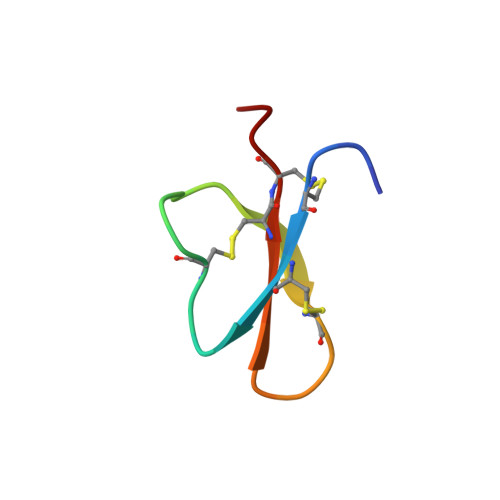The alpha-defensin salt-bridge induces backbone stability to facilitate folding and confer proteolytic resistance.
Andersson, H.S., Figueredo, S.M., Haugaard-Kedstrom, L.M., Bengtsson, E., Daly, N.L., Qu, X., Craik, D.J., Ouellette, A.J., Rosengren, K.J.(2012) Amino Acids 43: 1471-1483
- PubMed: 22286872
- DOI: https://doi.org/10.1007/s00726-012-1220-3
- Primary Citation of Related Structures:
2LEW, 2LEY - PubMed Abstract:
Salt-bridge interactions between acidic and basic amino acids contribute to the structural stability of proteins and to protein-protein interactions. A conserved salt-bridge is a canonical feature of the α-defensin antimicrobial peptide family, but the role of this common structural element has not been fully elucidated. We have investigated mouse Paneth cell α-defensincryptdin-4 (Crp4) and peptide variants with mutations at Arg7 or Glu15 residue positions to disrupt the salt-bridge and assess the consequences on Crp4 structure, function, and stability. NMR analyses showed that both (R7G)-Crp4 and (E15G)-Crp4 adopt native-like structures, evidence of fold plasticity that allows peptides to reshuffle side chains and stabilize the structure in the absence of the salt-bridge. In contrast, introduction of a large hydrophobic side chain at position 15, as in (E15L)-Crp4 cannot be accommodated in the context of the Crp4 primary structure. Regardless of which side of the salt-bridge was mutated, salt-bridge variants retained bactericidal peptide activity with differential microbicidal effects against certain bacterial cell targets, confirming that the salt-bridge does not determine bactericidal activity per se. The increased structural flexibility induced by salt-bridge disruption enhanced peptide sensitivity to proteolysis. Although sensitivity to proteolysis by MMP7 was unaffected by most Arg(7) and Glu(150 substitutions, every salt-bridge variant was degraded extensively by trypsin. Moreover, the salt-bridge facilitates adoption of the characteristic α-defensin fold as shown by the impaired in vitro refolding of (E15D)-proCrp4, the most conservative salt-bridge disrupting replacement. In Crp4, therefore, the canonical α-defensin salt-bridge facilitates adoption of the characteristic α-defensin fold, which decreases structural flexibility and confers resistance todegradation by proteinases.
- School of Natural Sciences, Linnaeus University, 39182 Kalmar, Sweden.
Organizational Affiliation:
















